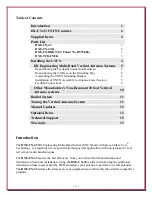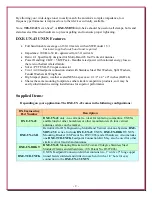
- 11 -
Remove the old Balun or Unun and replace it with the
DXE-UN-43
Unun. Connect the antenna
feedpoint to the terminal on the
DXE-UN-43
UNUN closest to the
Red "+"
on the label as
shown below. Do not over tighten the wing nuts. Hand tighten them only, do not use pliers or other
tools to over tighten the wing nuts. Connect the other terminal on the
DXE-UN-43
UNUN closest to
the
Black "
▬"
on the label to the closest radial wire bolt on the optional
DXE-RADP-3
Radial
Plate as shown below.
Before After DXE-UN-43 UNUN Connections
Radial System
The use of a radial system is a key requirement for performance in a vertical antenna system. The
radials are the second half of the antenna. The number of which contribute to the radiation
efficiency of the entire vertical antenna system.
At a minimum, 20 radials, each 32 feet long, should be used. Using 32 radials at 65 feet long is
preferred and highly recommended. The extra radials may help overcome unknown poor-soil
conditions, improve efficiency, and ensure the best performance possible from the vertical antenna.
Longer radials should be used for improved performance on the lowest frequency to be used if your
plans call for 60 or more radials.
DXE-RADW
Radial Wire, a stranded 14 gauge copper wire with
black relaxed PVC insulation, is suggested for the best results.
Tuning the Vertical Antenna System
The performance of any non-resonant antenna is highly dependent on the ability of your tuner to
deliver a low SWR when tuned. The use of a customer supplied, high quality, outboard tuner is
required for any multi-band non-resonant vertical antenna system. The tuner should be capable of
tuning the wide range of impedances presented by the antenna at the different operating frequencies.


































